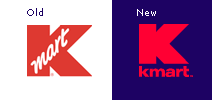On the way to the airport (and not far) from our house we — well, the taxi driver — drive by a Kmart that also houses a Subway, a buttons store and a GameStop, all bustling with activity. Two years ago, during a summer trip, the Kmart was open when we left for the airport and by the time we got back it had closed. And along with Kmart, the pretty-button store and all other small businesses. Today, the lot is deserted and silent, with all stores empty and their signs untouched and, to add to the depressing scene, there is a cemetery across the street. (A perfect spot to start a fight club). This, after Kmart announced it would close around 300 hundred stores nationwide in an effort to stay profitable following their announcement of bankruptcy in January of 2002.
Kmart has had their share of troubles over the years. Some with the Kathy Lee Gifford sweatshop scandal which indirectly affected Kmart; then the bankruptcy two years ago; and, of course, there is litte ol’ Martha’s problems with the law. While, reportedly, sales of the Martha Stewart brand did not drop, it must have taken an emotional toll on Kmart shoppers. But what ethical harm is there in buying a soft, cuddly Daylilly 4-star towel?

In October of 2002, Kmart opened four prototype stores introducing various changes to the shopping experience, including bigger aisles, better lighting and a slight change to the Kmart logo. Conceived by Arnell Group, the new logo stepped away from its red/blue brand recognition into a gray/lime green combination because, as Peter Arnell said, “I think it’s great being green,” and added “It does mean the future and it does mean growth.” The stores were simply prototypes and it is unclear whether bigger aisles and better lighting have been implemented in existing stores. Luckily, the gray/lime green logo stayed as a vague idea.
On May of 2003, Kmart officially emerged from bankrupcy status and in May 2004 they reported that for the fourth consecutive fiscal quarter, “Kmart Holding Corporation improved year-over-year profitability and liquidity”.

In an effort to put the troubled past behind (and hip future in front of) them Kmart has revised their logo to put emphasis on their big, bold, red K while dropping the script mart housed inside it. Perhaps in an effort to compete against Target’s red bull’s eye and separate themselves from stodgy, price-cutter Wal-Mart.

Lastly, to amp up the hip factor, Kmart has enlisted the stars of the WB to market their back-to-school campaign which gives plenty of play to the big K. The TV ads certainly reflect a new, fresher attitude from Kmart and almost make the deserted lot near our house seem fictitious. Yet, burying the past in TV ads with rocking music and pretty folks is no easy feat. But it’s a start.
Thanks to Amber Nussbaum and David Weinberger for links and insight.












I liked the way the angle cut into the gray/lime logo. It really enhanced the uniqueness of the logo. The red should definitely stay in the identity as well though. I just don't think removing the "mart" from the inside of the letter "k"is really enough to breath fresh air into the brand. It needed that clever angle.
But I could never stand by this kind of logic: as Peter Arnell said, “I think it’s great being green.” I really think designers have a responsibility to have stronger reasons for using certain colors other than something like "It looks cool". But to give Peter Arnell the benefit of the doubt, perhaps his comment was taken out of context.
And that letter spacing between the "k" and the "m" in the new blue and red logo look weird to me. Not to mention the bold "K" in the add doesn't seem to fit with the "MART".
On Aug.16.2004 at 10:01 AM